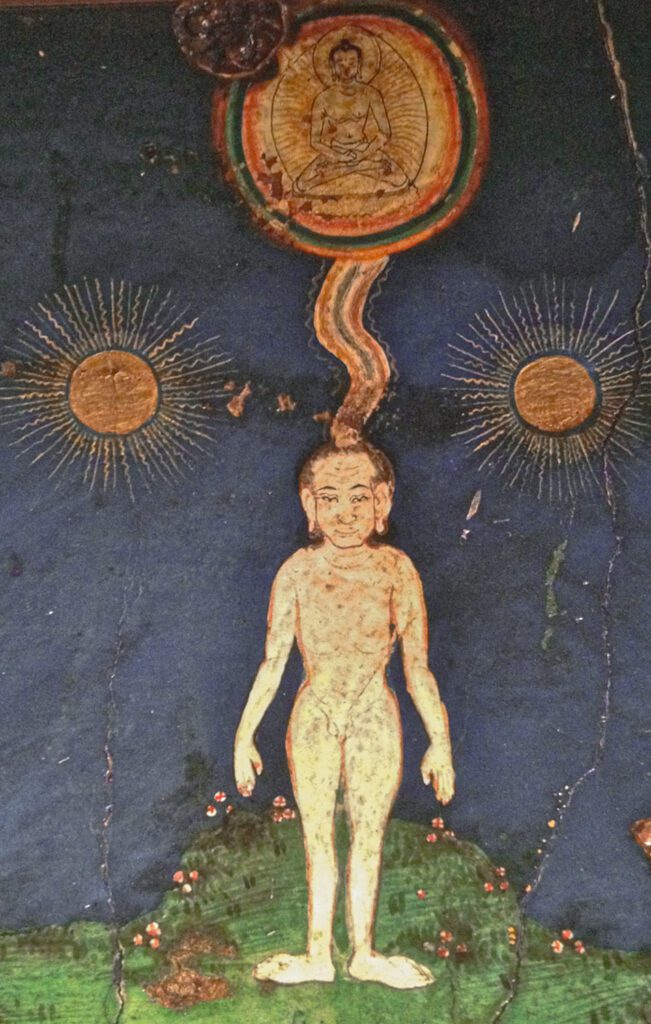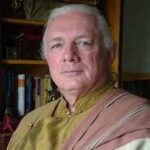Vajrayana practitioners of all levels of training are encouraged to cultivate some form of “death readiness,” the specific form being dependent on the meditative and yogic maturity of the individual.
The most basic form of this training is known as phowa, which can casually be translated as “blast off.” Every school of Tibetan Buddhism has several hundred manuals on phowa applications, with different sects often having their favorites. There also is a tradition of the professional phowa master visiting the home of a deceased practitioner and assisting them in the transference process. That said, I will here only address phowa from the perspective of a personal training.
The practice is mentioned by Karma Lingpa in his Bardo Thodol, published and translated in 1927 as The Tibetan Book of the Dead, in which he writes about the necessity of making a choice in the hours leading up to one’s death. One option is to die while applying the higher tantric practices and then engage in bardo yoga, consciously plunging into the afterlife bardo with the objective of achieving enlightenment there. This is a dangerous option, because a single distraction can lead to one being propelled out of the bardo and into whatever rebirth is in vibrational accord with the negative response to the specific bardo vision being mismanaged. The suggestion is that a response characterized by anger can result in a rebirth in one of the many hell realms, a response characterized by attachment or craving can propel one into rebirth as a disturbed spirit, and so forth.
The safer option is to engage in a phowa technique and altogether bypass the bardo and its alluring, beguiling visions. Here one instead takes what one learned from tummo (inner fire yoga) and the illusory body and clear light yogas, and projects one’s mind/energy stream directly to a higher rebirth, to continue one’s enlightenment path.
This style of conscious transition requires a strong resolution at the time of death, a reasonable level of meditative samadhi, and basic maturity in the inner fire yogas. This third quality is gained by training in the tantric yogas to bring the ten subtle energies that power the coarse physical body into the central core of one’s body, the so-called central channel that runs from the sexual center at the base of the pelvic floor to the top of the brain. Phowa training involves the “opening” of this central channel as an exit path.
One of my early experiences with phowa training came with a transmission I received in the late 1970s during my twelve-year training with Tibetan refugee lamas in Himalayan India. The transmission included a wang, lung, and tri (empowerment, oral transmission, and practice commentary) in a lineage descending from the First Dalai Lama, Gedun Drupa (1391–1475). The training involves the subtle art of dream observation for indications of a weakness in the cord of one’s lifespan, and attempting to repair the indicated damage by means of the longevity yogas. When these fail to remove the indications, one trains in phowa to open the death channel. Dream observation is only one of a half dozen means of observation mentioned in the first Dalai Lama’s text, but is the easiest to accomplish.
Both the Six Dharmas of Naropa and the Six Dharmas of Niguma state that the direct method for enlightenment in this lifetime is the cultivation of tummo, or inner fire. This is the first of the Six Dharmas and the foundation to be applied in all six. The actual practice bringing enlightenment is the cultivation of this inner fire so that it stretches into the two sides of our experience: the “I am experiencing something” side, and the “something is being experienced by me” side. In the Heart Sutra we read, “form is emptiness, emptiness is form; feelings are emptiness, emptiness are feelings; perceptions are emptiness, emptiness are perceptions,” and so on. In tantra, the terms form, feeling, perception, etc., refer to the conventional or illusory reality of being—that is, things as we experience them—and the emptiness side refers to the beyond-appearance nature. In the Prajnaparamita sutras, the Buddha refers to these as the two levels of truth or of reality: the deceiving level and the level of deeper significance. Vajrayana refers to them as gyulu, or “illusory physicality,” and osel, or “clear light.” In other words, by generating the inner fire of blissful consciousness, known as detong yerme yeshe, or “pristine awareness of bliss and emptiness,” one swims through the waters of the two levels of reality, conventional and ultimate, and achieves enlightenment in this lifetime.
The Six Dharmas teach methods for practicing tummo and developing it into illusory physicality during the day, both on and off one’s cushion, and illusory physicality as experienced at night, in dreams. The technology for this nighttime use is popularly known as dream yoga. Similarly, “clear light yoga as experienced during the day” refers to the peak blissful clear-light mind aroused through yoga during and between meditation sessions. “Clear light practice during the night” refers to the experience that is cultivated by remaining conscious through the four coarse and four subtle energy dissolutions that occur in the transition from waking consciousness to deep sleep. The eighth of these is the mother clear light mind that arises and serves as the window for passing from the waking state world into the dream world, where one awakens with a dream body. In the clear light of sleep yoga, one trains in resting in the clear light of the moment before sleep, which is supported only by the most subtle of the energies, and exploring the most subtle states of body and mind from that platform.
Many of the Six Dharmas traditions that exist today feature tummo, illusory body, and clear light yogas, together with dream yoga as practiced during the night, as methods of achieving enlightenment in this lifetime. The remaining two of the Six Dharmas—phowa and bardo yoga—are kind of a plan B for those who fail to achieve full enlightenment. The Lord of Death takes away their body-boat before the ocean to the jewel island of enlightenment has been fully crossed.
Dozens of phowa methods taught by the Buddha are listed in various tantric texts. The method that is best for a specific individual is said to be the one that most accords to the individual’s karmic predispositions, psychological profile, and spiritual maturity. The recommendation usually is made by one’s root lama.
All Vajrayana methods of phowa are performed on the basis of both refuge in the Three Jewels (Buddha, dharma, and sangha) and the bodhisattva spirit of the two bodhicittas. To understand this, it is useful to look at Lojong Dondonma, “The Seven Points for Training the Mind,” popular in all schools of Tibetan Buddhism. The first of these is the point of the general preliminaries, such as the four noble truths, the three higher trainings, the twelve links of dependent origination, and so forth. The second is the development of the bodhicitta in its two aspects—the universal mind of love and compassion, known as illusory bodhicitta; and the wisdom of emptiness, known as bodhicitta of deepest significance. The third is the cultivation of a mind that can transform hardships into aids in the development of the two bodhicittas. The fourth discusses signs of progress.
The fifth point is in two parts. The first discusses how to condense all the trainings in conventional and ultimate bodhicitta into five key points during our lifetime; and the second, how to condense these five points and utilize them at the time of death. The second part is simply known as lojong phowa, or “phowa from the Lojong tradition.” This Lojong tradition of phowa was brought to Tibet by the great Atisha, whose lineages came to pervade all schools of Tibetan Buddhism from that time until today. The five key points are: 1) “the power of the white seed,” meaning that whatever we do during and between meditation sessions should be dedicated to the development of the two bodhicittas; 2) “the power of resolve,” a dedication to always try to contribute toward the happiness of, and mitigate the suffering of, others, and to achieve enlightenment as the best way to keep these two aspirations as one’s basis; 3) “the power of transcendence,” which refers to releasing narcissistic tendencies that obstruct the two bodhicittas; 4) “the power of familiarity,” which means to practice mindfulness of the two bodhicittas at all times; and 5) “the power of prayer,” which means to always hold the prayer that one’s every experience can deepen one’s realization of the two bodhicittas.
Many of the Six Dharmas traditions that exist today feature tummo, illusory body, and clear light yoga, together with dream yoga, as methods of achieving enlightenment in this lifetime. Phowa and bardo yoga are kind of a plan B for those who fail to achieve full enlightenment.
At death, these five become known as “the five powers as applied in phowa.” Here 1) “the power of the white seed” means that, as one’s death draws near, one gradually divests oneself of all possessions, attachments, and so forth, dedicating them to auspicious purposes; 2) “the power of aspiration” becomes the prayer to be able to hold the two bodhicittas as guiding forces in every experience during the moment of the death, in the bardo and in one’s search for an appropriate rebirth; 3) “the power of transcendence” refers to avoiding a self-cherishing attitude and strengthening the powers of universal love and compassion in the transition process; 4) “the power of resolve” means that one generates a strong determination to recognize the clear-light mind of the time of death as buddha mind, and transform it into the dharmakaya, the formless radiance of buddha mind; to recognize the illusory manifestations in the bardo, and transform them into sambhogakaya, the blissful dimension of enlightenment; and, then, to take rebirth in a world and form wherein one can continue one’s enlightenment quest and the cultivation of the two bodhicittas; and 5) “the power of familiarity,” which means to lie on one’s right side in the lion posture, and pass away like a sleeping buddha, with no thought of attachment to body, relatives, friends, possessions, or dwelling.

The fifth point of the Lojong phowa is very similar to the practice of the first stage of Vajrayana practice, known as generation-stage yoga, in which one trains in self-identifying as a mandala deity through a practice known as kusum lamkhyer, or “carrying the three kayas of a buddha into one’s path to enlightenment.” (Every highest yoga tantra sadhana has this practice.)
One of the most popular phowa practices in Tibet is that associated with Chenrezig, the Buddha of Compassion. It is based on the tummo practices of the Indian mahasiddhas, utilizing the chakras and channels, but in the training we replace the three channels, four chakras, and so forth with a single tunnel of light running from the center of the body to the brahma aperture at the crown of the head. The tunnel is very thin at the base and widens as it goes up. In this meditation, one melts the entire outer world and coarse bodily energies into this death channel. The essence of mind and energy are held at the base of the tunnel, and then projected upward, from navel to top of the brain, using samadhi and energy control to initiate an “opening of the death channel.” The effort is to close the doors to any exit other than the brahma aperture and strengthen both the karmic habit and auspicious circumstance for leaving the body by this exit at the time of death.
The drop of mind and energy is held and released, up and down the center of the body in this way, until a blister is produced from the yogic flexing and redirection of the body’s electromagnetic field. The idea is that one opens the path of departure within oneself through tummo practice.
When the moment of death befalls, one can simply rest in seated meditation or lie down in the lion posture, reconstruct this passage in the mind, and comfortably rest within it. As life’s forces naturally unfold, one follows the unfolding of the dissolutions. Then, when the clear light of death arises, one holds it as long as possible before projecting the mind up and away. When one does this with a particular buddha form, one usually projects the ball of energy and consciousness that serves as the basis of a sense of self out through the mouth of the tunnel and to the heart of the buddha-form, visualized just above the crown of one’s head.
The buddha-form suggested in the phowa as taught in the Six Dharmas of Naropa is known as “Transference to the Heart of the Guru” (visualized in the form of Chakrasamvara in sexual union with Vajrayogini). Some alternative traditions suggest Amitabha Buddha; others suggest Chenrezig, the Buddha of Compassion. My personal favorite is as taught in the Six Dharmas of the Indian female mystic Niguma, where White Yogini is used as the yidam, or meditation deity. (It is said that if one is of a slightly aggressive nature one should use a white dakini, and if of a more passionate nature, to utilize a red dakini.) Here, the central channel is established, running from the base of the pelvic floor to the top of the brain, with the top of the skull open like a skylight window. One visualizes the essence of one’s sense of self as resting in the navel chakra, and the white naked dakini above one’s head, with her heels behind her ears and her birth passage pressed against one’s brahma aperture. This is a female tantra method, and basically appeals to the instinct to return to the womb of the mother in times of fear and anxiety. One imagines oneself at the base of the central channel, and looks up. One then engages the tummo practice, causing the energy ball of mind and prana to be projected up the channel to the open mouth of the brahma aperture. This lays the foundations of the path for conscious dying when the occasion occurs. Again, the practice is continued until a blister forms at the crown as a sign of success.
Phowa can be cultivated over a period of many years or in an intensive retreat of a month or more to yogicly prepare, so that if death falls suddenly one will be equipped to exit the body-boat in an auspicious and spiritually directed manner.
The great Lama Tsongkhapa states in a commentary that there are three kinds of practitioners. The first achieves enlightenment in this lifetime. The second achieves sufficient progress as to be able to consciously engage bardo yoga at the time of death, thus achieving liberation in the bardo. The third tries to establish at least a basic foundation of merit and wisdom in this lifetime, and successfully apply phowa at the time of death.
To conclude, I would like to quote a few verses from a mystical song the Seventh Dalai Lama (1708–1757) wrote:
When the moment of death comes to you,
Withdraw your mind from distortion, craving, and agitation.
Avoid the conceptuality such as hopes and fears
And take refuge in your gurus and Triple Gem,
Offering them your heart.
After the essential bases and the gross and subtle energies
Of the body have gradually dissolved,
The subtle mind of death arises.
Transform it into the essence
Of the path of clear light,
And abide there unwaveringly.
Gain meditation experience now
In the practices of the general Buddhist path,
The foundation of all spiritual realizations.
The moment you accomplish that, apply yourself
to the quick path,
Vajrayana, the way of secret methods.

